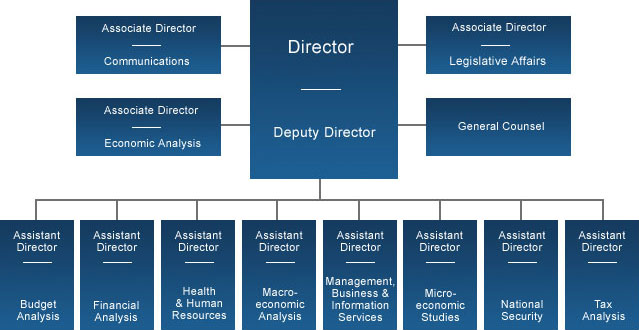General Information
- CBO Fact Sheet
- Staffing & Organization
- Panel of Economic Advisers
- Panel of Health Advisers
- Directions to CBO
- Visiting CBO

CBO's Role and Work
- CBO's Role in the Budget Process
- Timeline for Analyses
- What CBO Publishes
- Preparing and Distributing Estimates and Analyses
- Frequently Asked Questions

Contact Info
Congressional Budget Office
Ford House Office Building, 4th Floor
Second and D Streets, SW
Washington, DC 20515
Directions >
Congressional Affairs
(202) 226-2837
congressionalaffairs@cbo.gov
Media and Public Affairs
(202) 226-2602
communications@cbo.gov
Staffing and Organization
Click within the chart for descriptions, biographies, and staff listings.

Title II of the Congressional Budget Act of 1974 spells out the procedures for appointing CBO's Director and staff and authorizes the agency's annual appropriations.
The Appointment of the Director
The Speaker of the House of Representatives and the President pro tempore of the Senate jointly appoint the CBO Director, after considering recommendations from the two budget committees. The term of office is four years, with no limit on the number of terms a Director may serve. Either House of Congress, however, may remove the Director by resolution.
At the expiration of a term of office, the person serving as Director may continue in the position until a successor is appointed.
The current director—Douglas W. Elmendorf—has been appointed to serve from January 22, 2009, to January 3, 2011, completing the most recent four-year term of office.
| Douglas W. Elmendorf | January 22, 2009 - |
| Peter R. Orszag | January 18, 2007 - November 25, 2008 |
| Douglas Holtz-Eakin | February 5, 2003 - December 29, 2005 |
| Dan L. Crippen | February 3, 1999 - January 3, 2003 |
| June E. O'Neill | March 1, 1995 - January 29, 1999 |
| Robert D. Reischauer | March 6, 1989 - February 28, 1995 |
| Rudolph G. Penner | September 1, 1983 - April 28, 1987 |
| Alice M. Rivlin | February 24, 1975 - August 31, 1983 |
CBO's Staff
The Director appoints all CBO staff, including the Deputy Director, and all appointments are based solely on professional competence, without regard to political affiliation. The compensation of the Director and the Deputy Director is set by law at levels tied to the annual rate of compensation of House and Senate officers. The Director determines the compensation of all other staff.
Of CBO's total expenditures, the largest share by far is allotted to personnel. The agency currently employs about 250 people.
CBO is composed primarily of economists and public policy analysts. About 70 percent of its professional staff hold advanced degrees in either economics or public policy. For purposes of pay and employment benefits, all staff are treated as employees of the House of Representatives.
The Organization of CBO
CBO is a highly collaborative organization in which many major functions and projects involve a significant amount of cross-functional, interdivisional cooperation and consultation. Although specific divisions take a lead role in fulfilling CBO's mandates, most divisions contribute to those efforts in various ways.
The Macroeconomic Analysis Division develops the economic projections that underlie the cost estimates, budget projections, and analyses prepared by the Budget Analysis Division, the Tax Analysis Division, and the four program divisions--Financial Analysis, Health and Human Resources, Microeconomic Studies, and National Security. Those program divisions take the lead in preparing policy and program analyses requested by the Congress.
Budget estimates prepared by the Budget Analysis Division may rely on models and analyses developed by the program divisions. Analysts in the Budget Analysis Division may supply data on the budgetary impact of alternative options as part of analytic studies performed by those divisions. Coordination between the divisions helps ensure the consistency of CBO's products.